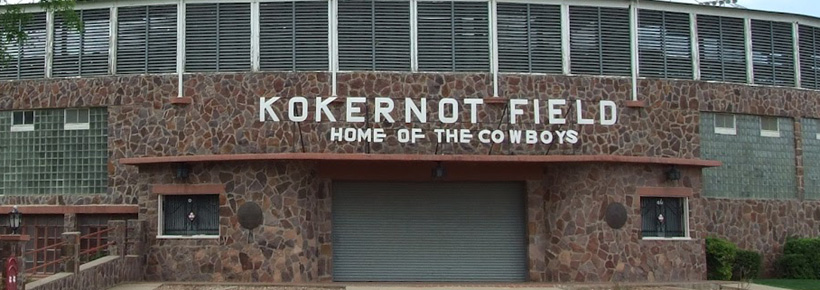He Built It. They Came: West Texas’ Iconic Baseball Diamond
By Joe Cook
Reporting Texas

Kokernot Field in Alpine, a classic baseball stadium built in 1947, continues to ring with collegiate and professional bats. Photo courtesy of Alpine Cowboys
Near the middle of the West Texas town of Alpine, light towers loom behind a stone façade bearing the words “Kokernot Field, Home of the Cowboys,” in white capitals. The national pastime has lived at this park for decades. Future Hall of Fame pitchers Satchel Paige and Gaylord Perry took the mound here. It’s all because of Herbert Lee Kokernot Jr.
Kokernot was a wealthy rancher in Alpine who managed the Kokernot 0-6 Ranch that his father had managed before him. He owned about 500,000 acres just over an hour away from Big Bend National Park.
When baseball caught his eye in the mid-1940s, he was hooked. Kokernot took over the Alpine Cats, a local independent team, and renamed the franchise the Alpine Cowboys, putting his ranch’s brand on his team.
The original field was not much to look at. “They put up a makeshift field, and he had the ranch brand and everything on it,” said Kristin Lacy Cavness, general manager of the current Cowboys franchise and Kokernot’s great-granddaughter.
That park is no longer standing. When Kokernot’s father saw the condition of the old facility, he told his son they needed to make a change.
“His father drove by one day and said, ‘If you’re going to put our brand on that field, you need to make it look great,’” Cavness said. “He did, and he built an amazing field.”
The field’s dimensions were 330 feet down the lines in left and right and 415 feet to straightaway center. The backstop was covered with huge pads, and the covered stands had green seats. The Twin Peaks of the Davis Mountains — then and now — are visible in the distance past right field, and the park stands across the street from Alpine High School.
Kokernot Field, built at a cost of more than $1 million, opened in 1947. Kokernot sought players at high schools throughout the state, offering to pay their tuition at Sul Ross State University in Alpine if they played for him.
Jim Shamblin, who played baseball for the University of Texas in 1949 and for the Cowboys in the early 1950s, remembers how well Kokernot treated his players.
“We lived in a hotel and signed tabs for everything that we wanted,” Shamblin said. “He picked up the tab. I went out to Alpine, and they gave me $100 a game. We had a hell of a time out there.”
Shamblin was awestruck by how much Kokernot owned.
“We were kids from Houston and Dallas, and we asked someone, ‘How many acres does Mr. Herbert own out there?’” Shamblin said. “He said, ‘Acres? I don’t think anyone knows. See that mountain? He owns everything up there and 18 miles to the other side of that mountain.’
“He owned something like 1,300 sections of land,” Shamblin said.
The team was popular in Alpine and surrounding cities. The Cowboys filled their park to its capacity of approximately 1,400 for almost every game.
“People from all those little towns came in,” Shamblin said. “They’d send a guy out with a loudspeaker to all the little towns around to remind people to come out.”
The Cowboys turned from semi-professional to professional in 1959, when they became a farm team for the Boston Red Sox. According to D.J. Stout, who wrote “The Amazing Tale of Mr. Herbert and His Fabulous Alpine Cowboys Baseball Club,” that led to the end of Kokernot’s team.
“The Cowboys quit playing in 1961,” said Stout, whose father pitched for the team. “Mr. Kokernot pulled the plug because he didn’t like the management. He didn’t like those Yankees telling him what to do — the Red Sox.”
Kokernot turned over control of his park to the Alpine Independent School District in 1968. In 1983, Sul Ross revived baseball, and its team now plays at Kokernot Field.
Professional baseball returned to Kokernot Field in 2009, when the Big Bend Cowboys of the Continental Baseball League played there briefly. After the 2010 season, the league folded.
The Big Bend Cowboys were reorganized for the 2011 season as the Alpine Cowboys when Cavness formed a nonprofit organization. They play in the Pecos League against teams from Kansas, Colorado, Oklahoma and New Mexico. The Pecos League is an independent league and not affiliated with Major League Baseball.
“We’re fixing up wood that has never been replaced,” Cavness said. “That’s one of the reasons why our nonprofit is helping, because people can donate money to go back into the field.”
Nolan Hoskins, an outfielder whose career with Sul Ross ended in 2014, cherishes his experiences at Kokernot Field.
“Kokernot Field was amazing to play at,” said Hoskins, now a baseball equipment manager at the University of Houston. “We had one of the best settings in the conference, if not the region or the nation. Looking over the center field wall you could see the Twin Peaks off in the distance, which created a majestic view.”
Hoskins said the history of the park helped lead him to Alpine.
“The chance to play on the same field as Satchel Paige was a great opportunity to be a part of history,” Hoskins said. “I am still asked about Kokernot Field. You either liked it or you loved it.”
Stout, a partner for Pentagram Design in Austin, experienced Kokernot Field only as a spectator. But he shares Hoskins’ love for the park.
“It’s a low-tech thing,” Stout said. “It’s like old-fashioned baseball. The whole town shows up. Every time I go, it makes me feel like the Cowboys from the ’40s and ’50s are playing again.”